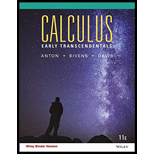
Concept explainers
(a) Find a slope field whose
(b) Prove that if
(c) Find an equation that implicitly defines the integral curve through
Want to see the full answer?
Check out a sample textbook solution
Chapter 8 Solutions
CALCULUS EARLY TRANSCENDENTALS W/ WILE
Additional Math Textbook Solutions
Calculus 2012 Student Edition (by Finney/Demana/Waits/Kennedy)
University Calculus: Early Transcendentals (3rd Edition)
Calculus, Single Variable: Early Transcendentals (3rd Edition)
Precalculus
Precalculus: Concepts Through Functions, A Unit Circle Approach to Trigonometry (4th Edition)
- Let q = - 2xy - y² + 2xz+2yz + z² be a quadratic form on R³ viewed as a polynomial in 3 variables. Find a linear change of variables tou, v, w that puts q into the canonical form in `Sylvester's law of inertia'!. What are the values of the associated indices s, t? Select one: O We let u = √3(x − y + 2), v = x+y, w = (x - y)/2 to find that q = u²+². Hence s = 2, t = 0 in Sylvester's law of intertia. O We let u = x - 2y, v = z+y, w = √3y to find that q=u²v² w². Hence s = 1,t = 2 in Sylvester's law of intertia. O we let u = x, v= √2(x+y), w = x+y+z to find that q = u²v² + w²2. Hence s = 2, t = 1 in Sylvester's law of intertia. O None of the others apply O The quadratic form does not obey the condition to be diagonalisable over R. This is because the minimal polynomial of the corresponding matrix is not a product of distinct linear factors. Hence Sylvester's law of inertia does not apply. By convention, we set s = t = ∞ when this happens.arrow_forwardQ2) a) Find Maclaurin expression of f (x) = Cosh (x) b)Find the gradient of the function f(x, y, z) = x2 +y³ – 2z + z In x at point P (2, 2,1)arrow_forwardConsider the equations x² - y²z³+w² +4 0 2xy + y² - 2z²+3w¹ +8 = 0. = (a) Show that near (a, b) = (xo, yo, zo, wo) = (2,-1, 2, 1), z and w can be expressed as differentiable functions of r and y. ди (b) Compute at (2,-1,2,1). ?хarrow_forward
- Sketch the slope field for y’ + y = 2 at the 25 gridpoints (x, y), where x = 0, 1, ... ,4 and y = 0, 1, ... ,4.arrow_forwardQ2) a) Find Maclaurin expression of f (x) = Cosh (x) b)Find the gradient of the function f (x,y,z) = x² + y³ – 2z + z ln x at point P (2, 2,1)arrow_forwardFind a vector that gives the direction of maximum rate of increase for the e2y cos x at (n/4,0). (-i+2j) (b) (d) (-i+j) VE (-i-2) (a)({ - ) (c) V2 O a O barrow_forward
- linearise R = AT + BT2arrow_forwardFind complex functionarrow_forwardQuestion 4 Find the gradient of the function at the given point. w = 2x - 4yz+z²; (1, 1, −2) 21+ 181-6k O6i+ 141-8K O 41+ 10j-8K O 41+ 10j-6k O 21+ 101-8k Question 5 Find the maximum value of the directional derivative at the point (3, 4) of the functic f(x,y) - Round your answer to two decimal places.arrow_forward
- 2. Let V be the set of all the solutions of the differential equation y" + w²y = 0 in the form y = c, cos wt + c2 sin wt , (with fixed w and arbitrary c, & c2 ). Show that V is a vector space with usual addition of functions and scalar multiplication.arrow_forwardLet g(z) = (23 + (z? - 1)5). Then the derivative of g is gʻe) = A(2? + (2? – 1)9)*(cP + F z(2? - 1)9), where + (z2 (? - 19)*(c zº + F z(z? - 1)9), where A = B : C = D = F = G =arrow_forwarda) Show that F (x, y) = (yexy + cos(x + y)) i + (xexy + cos(x + y) j is the gradient of some function f. Find f b) Evaluate the line integral ʃC F dr where the vector field is given by F (x, y) = (yexy + cos(x + y)) i + (xexy + cos(x + y) j and C is the curve on the circle x 2 + y 2 = 9 from (3, 0) to (0, 3) in a counterclockwise direction.arrow_forward
 Calculus: Early TranscendentalsCalculusISBN:9781285741550Author:James StewartPublisher:Cengage Learning
Calculus: Early TranscendentalsCalculusISBN:9781285741550Author:James StewartPublisher:Cengage Learning Thomas' Calculus (14th Edition)CalculusISBN:9780134438986Author:Joel R. Hass, Christopher E. Heil, Maurice D. WeirPublisher:PEARSON
Thomas' Calculus (14th Edition)CalculusISBN:9780134438986Author:Joel R. Hass, Christopher E. Heil, Maurice D. WeirPublisher:PEARSON Calculus: Early Transcendentals (3rd Edition)CalculusISBN:9780134763644Author:William L. Briggs, Lyle Cochran, Bernard Gillett, Eric SchulzPublisher:PEARSON
Calculus: Early Transcendentals (3rd Edition)CalculusISBN:9780134763644Author:William L. Briggs, Lyle Cochran, Bernard Gillett, Eric SchulzPublisher:PEARSON Calculus: Early TranscendentalsCalculusISBN:9781319050740Author:Jon Rogawski, Colin Adams, Robert FranzosaPublisher:W. H. Freeman
Calculus: Early TranscendentalsCalculusISBN:9781319050740Author:Jon Rogawski, Colin Adams, Robert FranzosaPublisher:W. H. Freeman
 Calculus: Early Transcendental FunctionsCalculusISBN:9781337552516Author:Ron Larson, Bruce H. EdwardsPublisher:Cengage Learning
Calculus: Early Transcendental FunctionsCalculusISBN:9781337552516Author:Ron Larson, Bruce H. EdwardsPublisher:Cengage Learning





